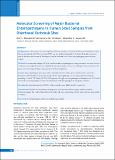Please use this identifier to cite or link to this item:
https://hdl.handle.net/20.500.14356/1988| Title: | Molecular Screening of Major Bacterial Enteropathogens in Human Stool Samples from Diarrhoeal Outbreak Sites |
| Authors: | Dixit, S Bhandari, G P Karmacharya, D B Shrestha, S Manandhar, S Maskey, M K |
| Citation: | DixitS., BhandariG. P., KarmacharyaD. B., ShresthaS., ManandharS., & MaskeyM. K. (2011). Molecular Screening of Major Bacterial Enteropathogens in Human Stool Samples from Diarrhoeal Outbreak Sites. Journal of Nepal Health Research Council. https://doi.org/10.33314/jnhrc.v0i0.272 |
| Issue Date: | 2011 |
| Publisher: | Nepal Health Research Council |
| Article Type: | Original Article |
| Keywords: | Bacterial pathogens Diarrhoea Multiplex pcr Nepal |
| Series/Report no.: | October;272 |
| Abstract: | Abstract Background: V. cholera types have been implicated often in a number of occasions in diarrhoeal outbreaks in Nepal. The recent outbreak in Far Western Nepal, 2009, was also attributed primarily to V. cholera. Molecular tools were used for the first time on some of the samples from the outbreak to screen for major pathogens present in those samples. Methods: A commercial multiplex PCR kit based bacterial enteropathogen screening assessment was carried out on 33 human stool samples from areas of a diarrhoeal outbreak in Nepal. A total of 10 pathogenic bacterial strains at the genus level were targeted using primers provided by the manufacturer. Results: Bacterial pathogens were detected in 23 samples (69.7%). Vibrio species was detected at an overall frequency of 36.4% followed by Aeromonas spp (33.3%) and Shigella spp (15.2%) along with Verocytotoxin producing E. coli (VTEC) family (15.2%). The frequency of singly occurring pathogen in all samples was 18.2% with most of the bacterial pathogens detected in combination with other pathogens at a frequency of 60.6%. The study also shows that majority 73 (86%) of the research centers didn’t start the research yet. Conclusions: This first ever molecular screening study shows that bacterial screening is indeed possible in diarrhoeal samples. The results obtained from this study will enable monitoring of future such outbreaks using similar techniques. Keywords: bacterial pathogens, diarrhoea, multiplex pcr, Nepal. |
| Description: | Original Article |
| URI: | http://103.69.126.140:8080/handle/20.500.14356/1988 |
| ISSN: | Print ISSN: 1727-5482; Online ISSN: 1999-6217 |
| Appears in Collections: | Vol 9 No 2 Issue 19 October 2011 |
Files in This Item:
| File | Description | Size | Format | |
|---|---|---|---|---|
| 272-Article Text-270-1-10-20130822.pdf | Fulltext Download | 697.01 kB | Adobe PDF |  View/Open |
Items in DSpace are protected by copyright, with all rights reserved, unless otherwise indicated.
